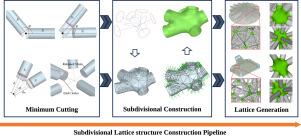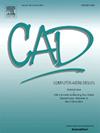Soap Film-Inspired Subdivisional Lattice Structure Construction
IF 3.1
3区 计算机科学
Q2 COMPUTER SCIENCE, SOFTWARE ENGINEERING
引用次数: 0
Abstract
Lattice structures, distinguished by their customizable geometries at the microscale and outstanding mechanical performance, have found widespread application across various industries. One fundamental process in their design and manufacturing is constructing boundary representation (B-rep) models, which are essential for running advanced applications like simulation, optimization, and process planning. However, this construction process presents significant challenges due to the high complexity of lattice structures, particularly in generating nodal shapes where robustness and smoothness issues can arise from the complex intersections between struts. To address these challenges, this paper proposes a novel approach for lattice structure construction by cutting struts and filling void regions with subdivisional nodal shapes. Inspired by soap films, the method generates smooth, shape-preserving control meshes using Laplacian fairing and subdivides them through the point-normal Loop (PN-Loop) subdivision scheme to obtain subdivisional nodal shapes. The proposed method ensures robust model construction with reduced shape deviations, enhanced surface fairness, and smooth transitions between subdivisional nodal shapes and retained struts. The effectiveness of the method has been demonstrated by a series of examples and comparisons. The code and associated data have been made available at: https://github.com/Qiang-Zou/Subdiv-Lattice.

肥皂膜启发的分区点阵结构构造
晶格结构以其可定制的微观几何形状和卓越的机械性能而闻名,在各个行业中得到了广泛的应用。它们设计和制造的一个基本过程是构建边界表示(B-rep)模型,这对于运行模拟、优化和工艺规划等高级应用程序至关重要。然而,由于晶格结构的高度复杂性,这种构建过程提出了重大挑战,特别是在生成节点形状时,鲁棒性和平滑性问题可能会从支柱之间的复杂相交中产生。为了解决这些挑战,本文提出了一种通过切割支柱和用细分节点形状填充空隙区域来构建晶格结构的新方法。该方法受肥皂膜的启发,使用拉普拉斯整流罩生成光滑的、保持形状的控制网格,并通过点法向环(PN-Loop)细分方案对其进行细分,以获得更细分的节点形状。该方法确保了模型构建的鲁棒性,减少了形状偏差,增强了表面公平性,并在细分节点形状和保留支柱之间实现了平滑过渡。通过一系列的算例和比较,证明了该方法的有效性。代码和相关数据已在https://github.com/Qiang-Zou/Subdiv-Lattice上提供。
本文章由计算机程序翻译,如有差异,请以英文原文为准。
求助全文
约1分钟内获得全文
求助全文
来源期刊

Computer-Aided Design
工程技术-计算机:软件工程
CiteScore
5.50
自引率
4.70%
发文量
117
审稿时长
4.2 months
期刊介绍:
Computer-Aided Design is a leading international journal that provides academia and industry with key papers on research and developments in the application of computers to design.
Computer-Aided Design invites papers reporting new research, as well as novel or particularly significant applications, within a wide range of topics, spanning all stages of design process from concept creation to manufacture and beyond.
 求助内容:
求助内容: 应助结果提醒方式:
应助结果提醒方式:


